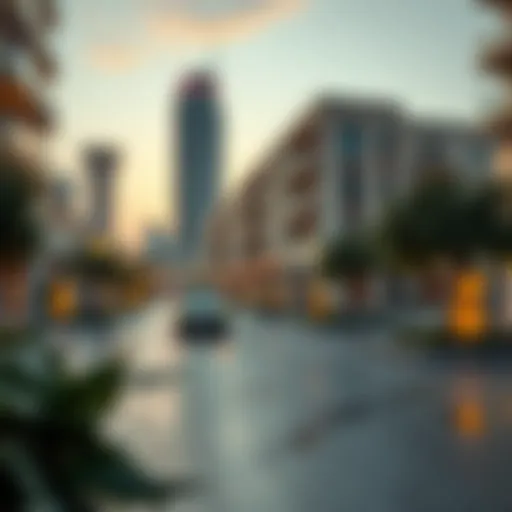Understanding Metro Station Opening Times in Dubai


Intro
The metro system in Dubai serves as a vital artery for the city, facilitating not just the movement of people but also playing a significant role in daily commerce and tourism. Comprehending the opening times of metro stations is essential for both residents and visitors navigating the bustling urban landscape.
In the age of rapid urbanization, accessibility is key, and the metro often defines the pulse of the city. Understanding its operational hours can greatly enhance the commuting experience. With varying schedules on weekends, holidays, and special events, keeping up with these details can save significant time.
Furthermore, how the metro's timings align with other factors like business hours, social activities, and local events reflects broader market trends. This insight is crucial for expatriates, investors, and homeowners, allowing them to mesh seamlessly into Dubai's dynamic rhythm.
Beyond transport, metro station openings influence tourism and real estate. Areas with convenient access to the metro typically see a rise in property values. Thus, understanding these times becomes not just a matter of convenience but an investment strategy as well. This article aims to peel back the layers of metro station opening times in Dubai, offering a comprehensive guide on the subject.
Overview of Dubai Metro
The Dubai Metro serves as a lifeline for many within the bustling metropolis, offering a swift and efficient mode of transit. Understanding its framework is crucial, especially when considering the operational hours that govern how and when people can move through the city. The importance of this topic lies not just in the numbers of trains running but how they harmonize with daily life, the influences driving those schedules, and their overall impact on the diverse communities living and working in this vibrant city.
History and Development
The Dubai Metro is not just a marvel of engineering; it’s a testament to the visionary leadership that propelled its inception. Construction began in 2006, driven by an aspiration to ease road congestion and provide a state-of-the-art public transportation system. The first phase, opened in September 2009, featured the Red Line, stretching from Rashidiya to Jebel Ali. The project aimed to reflect the city's ambitions for economic growth and urban development. Initially, there was skepticism about how often it would be used; however, the Metro quickly became a popular choice among residents and tourists alike. Its development has since continued, with new lines and stations regularly added to accommodate the ever-growing Dubai population.
Current Status of Operations
Today, the Dubai Metro operates over 75 kilometers with two primary lines – the Red Line and the Green Line – reaching 53 stations in total. This interconnected system is not only essential for local commuters but also plays an integral role in attracting tourists who wish to navigate the city's cultural and recreational hotspots. The metro operates daily, with regular trains arriving every few minutes during peak hours, demonstrating a commitment to efficiency and accessibility. All this is especially vital for investors and expatriates, as they need reliable transport options to explore neighborhoods, properties, and potential investments without the hassles of traffic.
As the Dubai Metro continues to grow, the relationship between its hours of operation and the dynamic nature of the city economy cannot be overstated.
Metro Station Opening Times Explained
Understanding the operational hours of Dubai's metro stations is crucial for both residents and visitors. This section sheds light on how these hours are structured, what considerations influence them, and why they matter to those navigating the city's vibrant transportation network. With the right information, users can plan their journeys efficiently, avoiding overcrowding and missed connections, while also considering the impact on real estate and local business operations.
Weekday Operations
On weekdays, Dubai Metro stations generally operate from 5 AM to 12 AM. This schedule allows commuters ample time to travel to and from work, school, or appointments. The 7-hour span from 5 AM to 12 AM during weekdays is designed to accommodate the hustle and bustle of city life, catering primarily to the office crowd and students.
- Morning Rush: The early helpers at rush hour can see trains arriving at intervals as short as two minutes, a boon for those trying to catch the 8 AM work wave.
- Off-Peak Hours: In the afternoons, the frequency might slightly drop as many workers head home. However, there’s still enough service to meet the needs of those who travel during non-peak hours.
This approach plays a pivotal role in ensuring commuters have access to timely transit options, thus alleviating the pressures of road traffic during peak hours.
Weekend Hours
Dubai Metro's weekend operation hours differ from weekdays. On Friday, stations open at 10 AM and operate until 1 AM the following day. On Saturdays, the hours revert to the typical 5 AM to 12 AM schedule. This slight shift follows cultural practices where Friday is a holy day, leading to a later start in metro services.
- Friday Dynamics: The mid-morning opening allows for the worship services that many attend, optimizing transport for those heading to various engagements.
- Saturday Consistency: The return to earlier hours on Saturday aligns with the reopening of the work-week and families out for leisure activities.
Comprehending these variations can help visitors plan their explorations or errands over the weekend, avoiding any missteps that lead to long waits.
Public Holidays
Public holidays in Dubai can lead to alterations in metro schedules, typically extending hours or adjusting openings. It's not uncommon to find the metro running for more extended periods during meaningful celebrations, allowing residents and tourists to partake in festive activities without the worry of transportation.


- Extended Hours: During National Day or Eid celebrations, for instance, the metro may open earlier and close later, ensuring accessibility to crucial events.
- Notice of Changes: It's advisable to check the official Dubai Metro website or local announcements for any changes on specific holidays, as these can fluctuate yearly.
Understanding these holiday schedules is key for those planning to attend major events or grouping excursions, preventing potential confusion.
"Being aware of the metro times can make or break your Dubai experience."
Factors Influencing Opening Times
The intricacies of metro station opening times in Dubai are shaped by various factors. Understanding these influences provides significant insights for investors, expatriates, and residents alike. The dynamic nature of a bustling metropolis like Dubai means that operational schedules can vary greatly based on different elements, which in turn affects travel patterns and daily life. By diving into these facets, one can better navigate the transport options available, optimizing time and efficiency.
Demand Patterns
When considering how opening times are decided, it is crucial to address demand patterns. These patterns are closely linked to population density, commuter habits, and peak traveling times. For instance, during weekday mornings, you can expect stations to be bustling as office-goers rush to their workplaces. Conversely, quieter hours may arise in the afternoon when many are already at their destinations.
In Dubai, the demand typically peaks from 7 AM to 9 AM and again from 4 PM to 7 PM. This is when the city’s workforce is at its busiest, resulting in longer wait times and crowded trains. On the weekends, demand shifts significantly, as residents and tourists alike seize the opportunity to explore various attractions.
- Workweek Peaks: Heavy usage during rush hours
- Weekend Explorations: Different demands from tourists and locals
Ultimately, the tailored opening times aim to accommodate this ebb and flow, ensuring that the metro remains a viable option for daily commuters.
Seasonal Variations
In a location like Dubai, seasonal variations play a significant role in determining how and when the metro operates. The extreme temperatures experienced in summer can lead to fluctuations in commuter numbers. For example, during the months of June through September, when the heat often exceeds 40 degrees Celsius, people are less likely to walk long distances. This can increase reliance on the metro, prompting adjustments in operating hours to ensure service meets the demand.
On the flip side, the much milder winter months, particularly from November to March, attract both tourists and residents to outdoor activities. Consequently, more extended hours may be adopted to accommodate evening gatherings and leisure activities, allowing people more flexibility with their travel times.
Government Regulations
Lastly, government regulations significantly dictate metro station hours. Authorities in Dubai aim to ensure safety, efficiency, and sustainability in public transport services. Regulations can change based on various factors—including public holidays, special events, and infrastructural projects. For example, during Eid celebrations or the Dubai Shopping Festival, extended hours are often put in place to cater to increased traffic.
Legislation regarding public transport, such as laws governing public transport during emergencies or heightened traffic conditions, can also impact opening hours. Moreover, the metro serves as a reflection of the city's commitment to urban mobility, thus ensuring that their regulatory framework supports the operational needs of the metro system.
"Public transport is not just a service; it's a lifeline of the city that reflects its growth and adaptability."
Through understanding these dynamics—demand patterns, seasonal variations, and government regulations—investors and residents alike can make better-informed decisions about their commuting habits. This awareness can lead to a more efficient use of the metro system, thus allowing for clearer planning when navigating the vibrant city of Dubai.
Impact of Opening Times on Commuters
The operational hours of the metro stations in Dubai play a crucial role in shaping the daily experiences of commuters. Understanding these opening times can directly influence one’s routine, affect punctuality, and even impact broader economic aspects, like employment and tourism. For residents and visitors alike, the metro isn’t just a means of transportation; it's often a lifeline connecting them to work, education, and leisure activities. Opening times reflect the demand and help to categorize the commuter population into specific cohorts based on their schedules.
Commuter Trends
Different demographics utilize the metro system in various ways. For instance, working professionals primarily travel early in the morning and later in the afternoon, seeking to beat rush-hour congestion. Conversely, tourists tend to visit during the day, utilizing the metro to access cultural attractions and shopping destinations. This distinction is vital.
- Peak hours: The busiest periods—for example, Sundays to Thursdays from 7 AM to 9 AM and 5 PM to 8 PM—showcase a significant uptick in use, necessitating efficient scheduling of trains.
- Off-peak hours: Lighter commuter flows are often observed later in the evening and during holidays, which affects how resources are allocated.
The insights gleaned from these trends allow the metro authority to adjust their services accordingly, striking a balance between efficiency and convenience for diverse commuters.
Challenges Faced by Users


Despite the well-structured operational approach, users do face several challenges related to the opening times. Understanding these issues can shed light on areas needing improvement.
- Limited Late-Night Services: Many commuters find themselves without options when they need to travel after regular metro hours. This can be particularly limiting for hospitality workers and late-shift employees.
- Confusion on Holiday Hours: Not every passenger is aware of altered schedules during public holidays, leading to frustration and potential latency in daily plans.
- Overcrowding During Rush Hours: Train congestion can become unbearable, making the ride uncomfortable. This is especially true when trains do not run frequently enough to accommodate large numbers of passengers.
These challenges highlight the importance of consistent communication and flexible operational strategies.
Recommendations for Ease of Use
To address the issues faced by commuters, various strategies can enhance the experience of using the metro system in Dubai. Here’s a brief overview:
- Extended Operating Hours: Introducing additional late-night services could cater to night shift workers and improve overall commuter satisfaction.
- Clear Communication about Schedule Changes: Ensuring that updates are disseminated effectively will help users navigate holiday schedules without confusion. Implementing real-time notifications via social media or dedicated mobile apps could be invaluable.
- Improved Frequency during Peak Hours: Adjusting the intervals between trains during rush hours can alleviate overcrowding, ensuring a more pleasant commute.
By adopting these recommendations, the Dubai Metro can significantly boost its service effectiveness, meeting the diverse needs of commuters while fostering a robust urban transportation network.
The Role of Technology in Enhancing Metro Experience
In the fast-paced urban landscape of Dubai, the role of technology in the metro system cannot be overstated. It serves not only as a backbone of the city's public transport but also as a critical enhancer of user experience. By integrating modern technological solutions, the Dubai Metro aims to meet the needs of a diverse population, making commutes smoother, more efficient, and ultimately more enjoyable for both residents and visitors.
Real-Time Information Systems
At the heart of this technological advancement are the real-time information systems. These systems provide commuters with immediate access to essential transport data. Whether you’re hopping on the red line to get to Dubai Marina or changing to the green line at BurJuman, knowing when the next train is arriving can make a world of difference.
Benefits of Real-Time Information
- Timeliness: Commuters can plan their journeys with confidence, minimizing waiting times.
- Flexibility: With unpredictable travel behaviors, these systems allow riders to adjust their schedules on the fly, optimizing their travel experience.
- Information Accessibility: Digital displays at stations and within trains offer updates not only about train arrivals but also any potential delays or service changes.
These signals of information empower commuters to make informed decisions. Imagine a tourist who has just landed at Dubai International Airport, eager to explore. Access to real-time updates can steer them towards a well-timed adventure rather than a frustrating wait at the station.
"Providing commuters with real-time updates allows them to adapt their travel plans instantly, fostering a more efficient commuting experience."
Mobile Applications for Commuters
It's not just the stations that are getting a tech upgrade. Mobile applications have transformed the way daily commuters interact with the metro system. The Dubai Metro app enables users to view schedules, purchase tickets, and even navigate the metro map with ease.
Key Features of Mobile Apps
- Ticketing System: Commuters can buy tickets ahead of time, saving them from queueing at kiosks.
- Route Planning: Step-by-step guidance through the metro routes, ensuring that even those who are not local find their way without feeling lost.
- Service Alerts: Notifications about service updates, helping commuters avoid unexpected disruptions.
Using these apps, expatriates who are new to Dubai can navigate the city like seasoned residents. The interface is user-friendly, accommodating different languages, which is an added benefit for a diverse community.
The integration of technology into the transportation experience is a critical aspect of Dubai's growth as a smart city. It ensures that as the population grows and tourism flourishes, the metro system can adapt and evolve without skipping a beat.
Metro Station Accessibility Considerations
Understanding the accessibility of metro stations in Dubai isn't just about physical structures; it intertwines with the broader fabric of urban life, catering to the diverse needs of residents and visitors alike. As Dubai continues to evolve as a global city, ensuring that metro stations are equipped for all users becomes pivotal for fostering inclusivity. Accessibility impacts daily commuting experiences, tourism, and even real estate trends. It serves as an essential cornerstone in making public transport a viable option for everyone, not just a select group.
Design Features for All Users
The design of metro stations in Dubai has undergone significant advancements to cater to various groups, including those with disabilities, the elderly, and families with young children. Various explicit features make these stations not just physical spaces but inclusive environments.


- Elevators and Ramps: Every metro station is equipped with multiple elevators and ramps, ensuring smooth access for wheelchair users and strollers. These amenities are strategically placed near ticket counters and platforms, minimizing the distance one has to travel.
- Tactile Guidance Systems: These systems are installed to aid those with visual impairments. Textured paths on the ground guide users to crucial areas such as ticket machines, lifts, and platforms, enabling independent navigation.
- Signage: Clear, multi-lingual signage helps not only those who might have language barriers but also assists non-native speakers among the diverse populations in Dubai. Station maps and instructions are designed to be intuitive, addressing varying levels of familiarity with public transport systems.
It's crucial that these design features don't become an afterthought but rather integrated into the initial planning stages. Well-designed stations reflect the city's commitment to inclusivity and respect for all commuters, showing that accessibility and aesthetic aren’t mutually exclusive.
Transport Links to Key Areas
Accessibility transcends the physical aspect of metro stations; it's also about the connectivity provided to key areas around the city. Well-planned transport links not only streamline commuting but also enhance the overall efficiency of urban mobility.
- Proximity to Major Landmarks: Dubai Metro stations are strategically placed to connect users to vital spots like shopping malls, business districts, and cultural hubs. For instance, the Burj Khalifa/Downtown Metro Station serves not only the residents but also tourists heading to the towering landmarks nearby.
- Integration with Other Transport Modes: A well-coordinated transport system ensures that metro stations connect smoothly with buses and taxis. For example, intermodal links allow smooth transitions from the metro to buses heading toward the suburban areas, making it convenient for daily commuters and tourists alike.
- Future Expansion Plans: The ongoing projects in the metro network aim to add stations in less populated areas, hence broadening accessibility further. These expansions will also provide links to new developments, including residential and commercial spaces, thus keeping pace with the city's growth.
These transport links reflect Dubai's commitment to improving urban mobility, emphasizing that the journey begins not just at the destination but at the accessibility and the connections made along the way.
"Accessibility isn't merely a feature; it’s a fundamental right that underscores a city's dedication to its inhabitants and visitors."
In summarizing how accessibility considerations play a crucial role in the metro system of Dubai, it's evident that they serve dual purposes: facilitating ease of movement while promoting a sense of community inclusivity. This understanding not only benefits daily users but also enhances the appeal of Dubai as a globally connected urban hub.
Cultural and Social Significance of Metro
The Dubai Metro is not just a transportation system; it represents a significant cultural and social artery within the bustling metropolis. The role it plays goes beyond mere convenience, weaving through the fabric of daily life in Dubai and enhancing the urban experience for both locals and visitors.
Convenience for Tourists and Residents
For tourists, navigating the vast city can be a daunting task. The Dubai Metro offers them a reliable, efficient, and user-friendly mode of transport. With its extensive routes connecting major attractions — from the iconic Burj Khalifa to the luxurious Dubai Mall — visitors can explore with ease. It's worth noting that the affordability of tickets further attracts many; ease of access means that even those on tight budgets can partake in the city's offerings.
Residents also reap the benefits. Imagine stepping onto a clean, air-conditioned train that shuttles you to your workplace or favorite hangout spot. The metro reduces travel stress for daily commuters, allowing them to reclaim their time. In an area where traffic congestion can cause woes, the metro stands out as an effective workaround. As the saying goes, "Time is money," and with the metro, one can save both.
Promoting Sustainable Urban Mobility
The environmental aspect of urban transport is increasingly in focus, especially in a rapidly developing city like Dubai. The metro embodies a commitment to sustainable urban mobility.
- Less congestion: By offering a viable alternative to car travel, the metro alleviates some of the traffic clogs, thus minimizing air pollution.
- Energy-efficient operations: Dubai Metro operations are designed with energy conservation in mind. It utilizes cutting-edge technology to minimize energy use while maintaining high levels of performance.
- Reduced carbon footprint: By encouraging mass transit, the metro effectively lowers the number of individual vehicles on the road, contributing to significant reductions in greenhouse gas emissions.
This societal shift towards more sustainable practices reflects not just on individual choices but also collective urban planning. As cities struggle with pollution and other environmental dilemmas, the Dubai Metro's example serves as a beacon for other urban areas.
Future Developments and Expectations
Understanding the future of metro station opening times in Dubai is essential not just for daily commuters but also for investors, real estate agents, and expatriates. As Dubai continues to expand and evolve into a global hub, it is vital to recognize how changing transportation schedules can influence the dynamics of urban living and commercial opportunities. Moreover, adapting to these changes makes it possible for the city to cater to the varying demands of its residents and visitors over time.
Potential Changes in Scheduling
With the growth of population and increasing tourism in Dubai, the need for flexible scheduling is paramount. The Dubai Metro's opening times may see adjustments to accommodate a shifting demographic landscape. Potential changes can include:
- Extended hours during peak tourist seasons: As more visitors flock to the city, especially during events like the Dubai Shopping Festival or major expos, extended metro hours could provide vital access to the attractions that customers wish to visit.
- Increased frequency during major events: The metro service may introduce more frequent trains during events, delivering a boost in capacity and convenience for both residents and tourists.
- Adaptive schedules based on data: By leveraging real-time ridership data, the Dubai Metro authority may reconfigure timings to respond to actual commuter patterns, optimizing resource allocation.
In considering these scheduling changes, it is important to align them with seasonal festivities and cultural events, ensuring the metro service supports Dubai’s vibrant culture.
Upgrades to Infrastructure and Technology
As society progresses, so too must the infrastructure that supports it. Upgrades to the Dubai Metro system are critical in enhancing commuter experience and optimizing operational efficiency. These upgrades may encompass:
- Smart ticketing solutions: Implementation of advanced payment systems, like mobile wallets, would make the fare process quicker and simpler, minimizing queues at ticket counters.
- Interactive displays at stations: Enhancements in technology would allow commuters to interact with touchscreens or mobile applications, providing them with real-time updates on train arrivals and service changes, thereby improving their overall journey.
- Improved station amenities: Upgrading bathrooms, adding Wi-Fi access, and installing comfortable waiting areas will cater to the needs of commuters, making their experiences more pleasant.
Implementing these upgrades could lead to a more efficient metro network, capable of better servicing an increasing ridership while simultaneously enriching the daily life of Dubai’s residents. The future of the metro system, emphasizing technology and modern convenience, suggests a commitment to building a stronger urban community.
As Dubai moves towards a more interconnected future, adapting metro opening times and upgrading services will be key in fostering a seamless urban experience for all.











